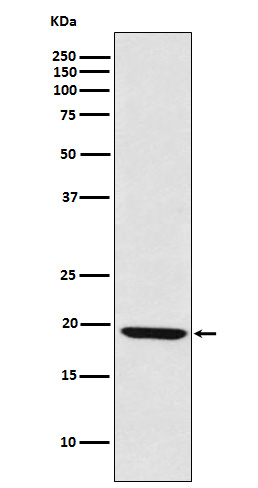
| WB | 1/500-1/1000 | Human,Mouse,Rat |
| IF | 1/20 | Human,Mouse,Rat |
| IHC | 咨询技术 | Human,Mouse,Rat |
| ICC | 技术咨询 | Human,Mouse,Rat |
| FCM | 1/50-1/100 | Human,Mouse,Rat |
| Elisa | 咨询技术 | Human,Mouse,Rat |
| Aliases | TTG2; LMO-2; RBTN2; RHOM2; RBTNL1 |
| Entrez GeneID | 4005 |
| WB Predicted band size | Calculated MW: 18 kDa; Observed MW: 18 kDa |
| Host/Isotype | Rabbit IgG |
| Antibody Type | Primary antibody |
| Storage | Store at 4°C short term. Aliquot and store at -20°C long term. Avoid freeze/thaw cycles. |
| Species Reactivity | Human,Mouse,Rat |
| Immunogen | A synthesized peptide derived from human LMO2 |
| Formulation | Purified antibody in PBS with 0.05% sodium azide. |
+ +
以下是关于LMO2抗体的3篇代表性文献及其摘要的简要概括:
---
1. **文献名称**: *LMO2 protein expression predicts survival in patients with diffuse large B-cell lymphoma treated with anthracycline-based chemotherapy*
**作者**: Béné MC, et al.
**摘要**: 该研究通过免疫组化分析LMO2蛋白在弥漫大B细胞淋巴瘤(DLBCL)中的表达,发现LMO2高表达与患者接受蒽环类化疗后的生存率显著相关,提示其可作为DLBCL的潜在预后标志物。
---
2. **文献名称**: *LMO2 is a robust immunohistochemical marker of T-lymphoblastic leukemia/lymphoma*
**作者**: Dave SS, et al.
**摘要**: 研究验证了LMO2抗体在区分T淋巴母细胞白血病/淋巴瘤(T-LBL)与其他淋巴瘤亚型中的特异性。结果显示,LMO2在95%的T-LBL病例中强阳性,而在外周T细胞淋巴瘤中阴性,支持其作为诊断T-LBL的关键标志物。
---
3. **文献名称**: *LMO2 activation by deacetylation enhances its oncogenic function in leukemia*
**作者**: Meng FL, et al.
**摘要**: 该研究利用LMO2抗体探究其在白血病中的分子机制,发现LMO2通过去乙酰化修饰增强其转录活性,促进白血病细胞的增殖和存活,为靶向LMO2的表观遗传调控提供了理论依据。
---
这些文献分别从预后评估、诊断应用和分子机制层面探讨了LMO2抗体的研究价值。如需具体文献链接或更多扩展,可进一步补充说明。
The LMO2 antibody is a crucial tool in studying the role of the LMO2 (LIM Domain Only 2) protein, a transcriptional regulator involved in hematopoiesis and oncogenesis. LMO2. part of the LIM-only protein family, lacks a DNA-binding domain but interacts with transcription factors like TAL1 and GATA proteins to modulate gene expression during blood cell development. Its gene, located at chromosome 11p13. was initially identified due to its involvement in T-cell acute lymphoblastic leukemia (T-ALL), where chromosomal translusions (e.g., t(11;14)) lead to aberrant LMO2 overexpression.
In diagnostics, LMO2 antibodies are widely used in immunohistochemistry (IHC) to detect LMO2 protein expression in lymphoid malignancies. It serves as a biomarker for germinal center-derived B-cell lymphomas, particularly diffuse large B-cell lymphoma (DLBCL), where nuclear LMO2 expression correlates with better prognosis. Additionally, LMO2 antibodies aid in distinguishing Burkitt lymphoma from DLBCL.
Research applications include studying LMO2's role in normal hematopoietic stem cell development and its oncogenic potential in leukemia models. The antibody is also utilized in Western blotting, flow cytometry, and immunofluorescence to explore protein interactions and signaling pathways.
Commercial LMO2 antibodies are typically monoclonal, raised against specific epitopes, and validated for specificity. Their utility underscores LMO2's dual role as a developmental regulator and oncogene, making it a key target in both basic research and clinical pathology.
×